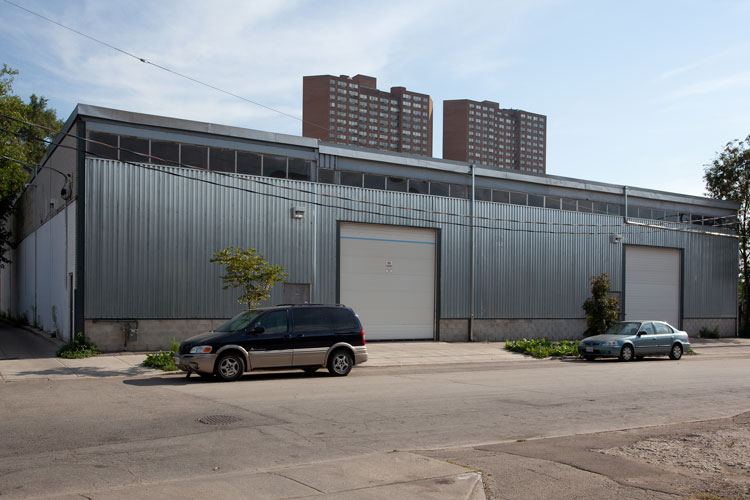Arsenal Toronto, a new art gallery in the city, follows the traditions of modern, cutting edge New York City galleries and is a smaller version of its Montreal namesake.
Arsenal Toronto is a converted lumber warehouse, situated within a residential Dundas West neighbourhood at 45 Ernest Avenue. The exterior is uninviting, box-shaped and sheathed in corrugated metal. As the viewers enter the gallery, they discover that the metal sheaths of the outside contrast with the smooth, sterile-white walls of its interior. The gallery is large, with polished concrete stretching out under high ceilings of exposed metal. It’s industrial-sized, minimalist aesthetic is ideal for large-scale abstract works.
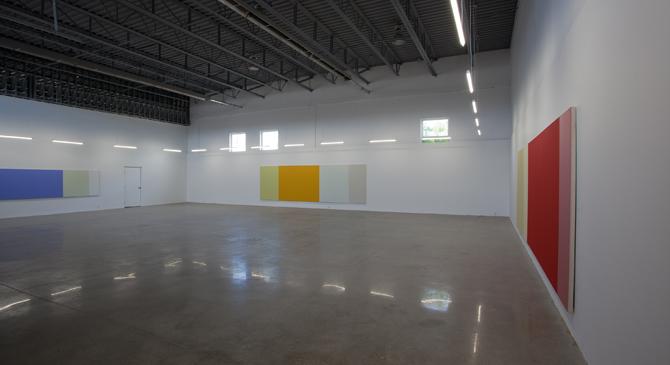 Arsenal Toronto, installation view
Arsenal Toronto, installation view
The grey palette of Arsenal Toronto’s exterior emphasized the bright hues of its Summer Colours exhibition.
Visitors entered the gallery through a concrete, side-door into a small hallway and were optically stricken by the yellow glare of Daniel Buren’s Travaux Situes “C” (1990).
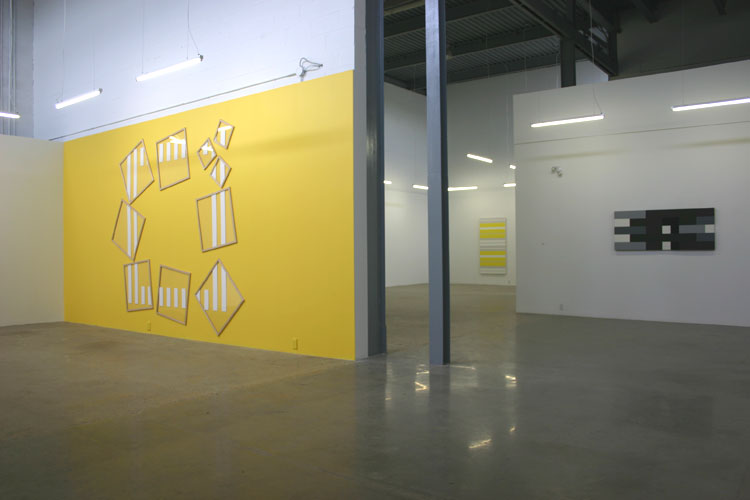 Installation view with Daniel Buren’s Travaux Situes “C”
Installation view with Daniel Buren’s Travaux Situes “C”
This large art work abandons the traditional methods of art presentation. Traditionally, art is moved from gallery to gallery. Instead, Travaux Situes “C” relies on the space which it is presented in. The work consists of a yellow painted entry wall, with hanging square wood forms and white strips. It was re-staged and assembled by personnel at Arsenal Toronto according to the the artist’s concept. Buren sent detailed instructions for the recontruction of Travaux Situes “C”, requiring the application of a particular kind of paint and the hanging of the forms based on specific proportions. Buren challenges the idea of authorship by allowing others to re-construct his artworks, and by doing so, he provokes the seemingly easy, but complex question we all sometimes ponder: What makes art, art?
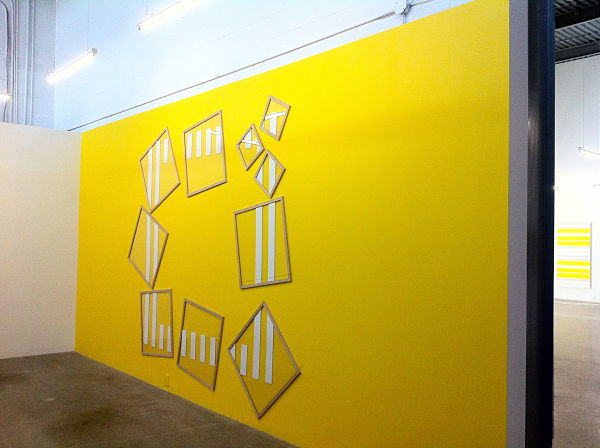 Daniel Buren, Travaux Situes “C” (1990). Photo: Marie van Zeyl
Daniel Buren, Travaux Situes “C” (1990). Photo: Marie van Zeyl
Barry Allikas in his work All Along the Watch Tower (2011) revamps a traditionally high-modern, non-objective kind of abstraction to embrace freedom in composition with lyrical forms. His hard-edged patterns in white, blue and red create a seemingly perfect composition where the eye moves smoothly around the canvas.
 Installation view with Barry Allikas works
Installation view with Barry Allikas works
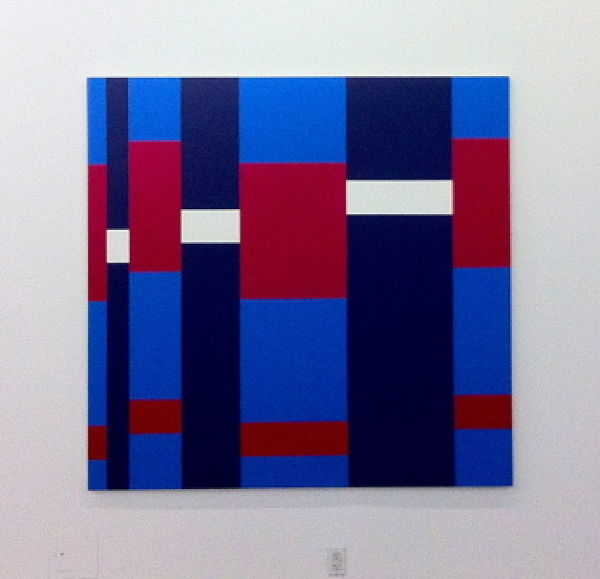 Barry Allikas, All Along the Watch Tower (2011). Photo: Marie van Zeyl
Barry Allikas, All Along the Watch Tower (2011). Photo: Marie van Zeyl
The largest room was dedicated to the late Yves Gaucher as a tribute. He passed away in 2000.
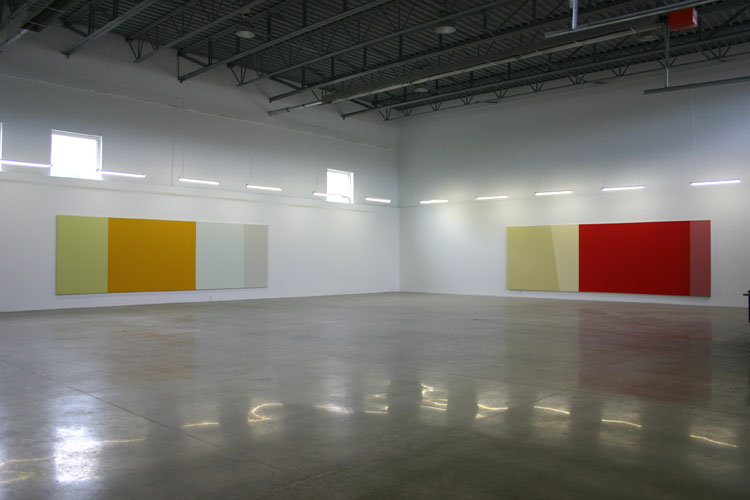 Installation view with Yves Gaucher’s works
Installation view with Yves Gaucher’s works
The viewer had to step back in order to investigate the flat planes of antagonistic colours in Gaucher’s large-scale canvases. The white frame of wall that surrounds the painting titled Reds and Ps (1992) enables the viewer to experience the artwork with no distraction. However their eyes will not move smoothly across the canvas. This abstract work depicts colour blocks of bright and muted reds and yellows, that are unequal in weight and energy buiding an unusual spatial experience. Gaucher uses a diagonal and vertical line to disrupt the entire rhythm of the canvas. The diagonal line pushes the viewer’s eye forward until the vertical line requires the eye to stop on a block of bright red colour.
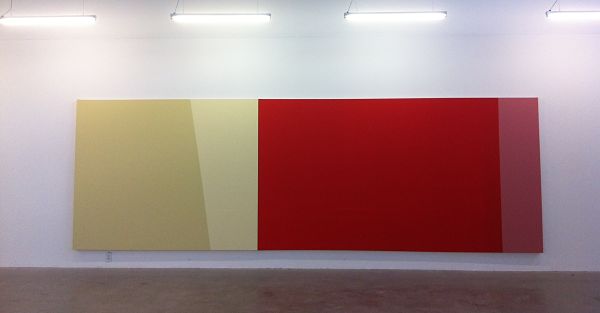 Yves Gaucher, Reds and Ps (1992). Photo: Marie van Zeyl
Yves Gaucher, Reds and Ps (1992). Photo: Marie van Zeyl
The artworks of Summer Colours were illuminated by both streams of daylight shining in from high-mounted windows and evenly spaced tubes of fluorescent light, suspended above the canvases by wires. The gallery space is bare, void of benches. The minimalist aesthetic of the space compliments the geometric perfection that all three artists embrace in their works.
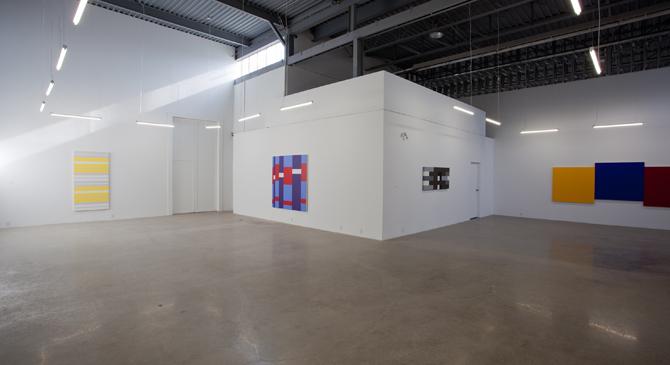 Summer Colours installation view
Summer Colours installation view
The exhibition at Arsenal Toronto by Daniel Buren, Barry Allikas and Yves Gaucher was jointly organized by Galerie Division and Galerie Rene Blouin. The show opened this summer and was on dispaly between June 27 and October 27.
Marie van Zeyl

